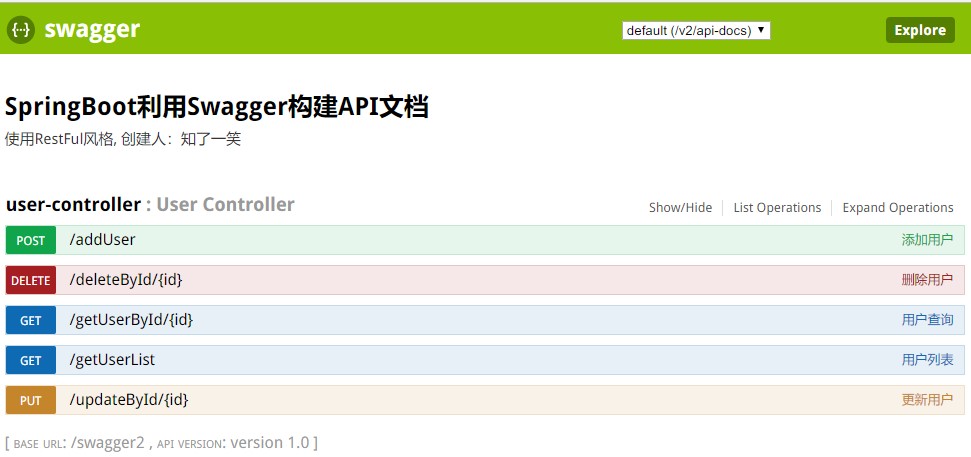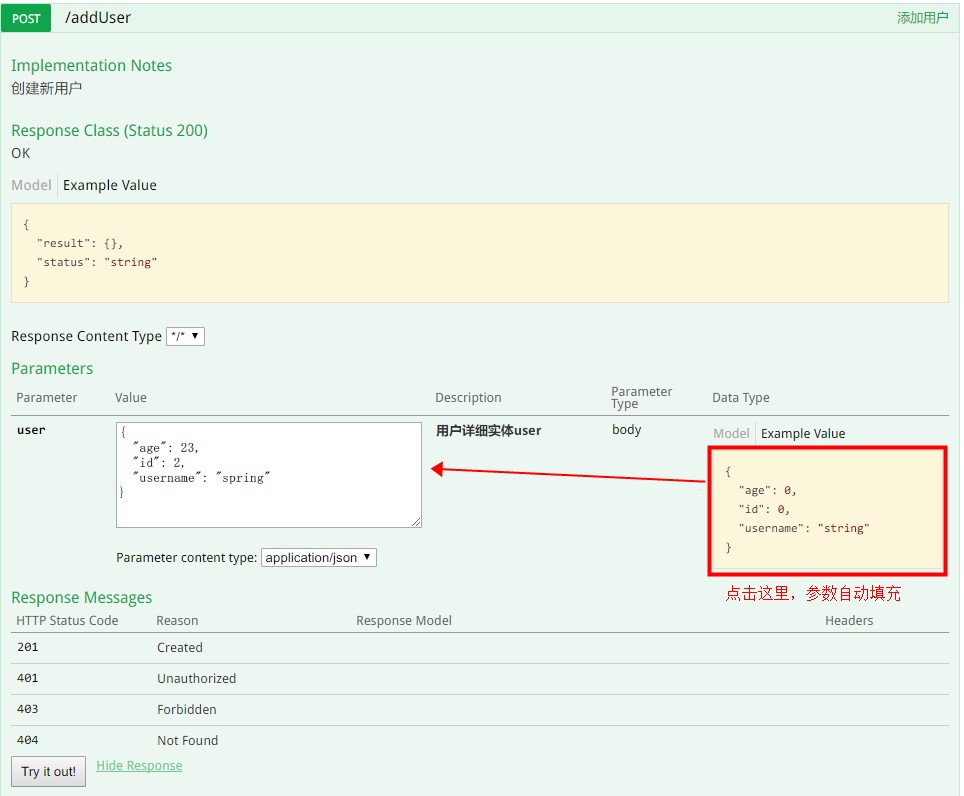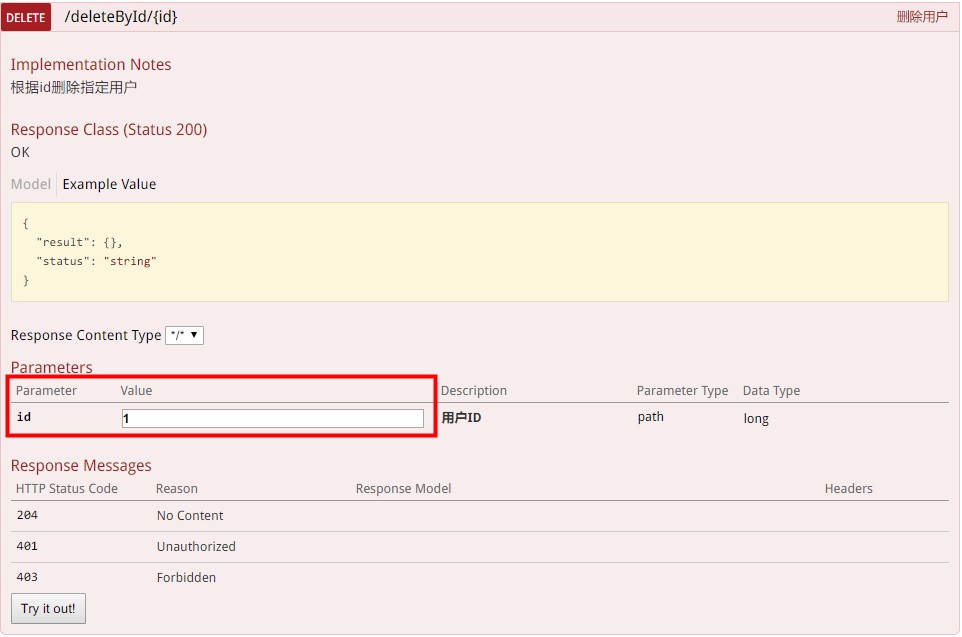I. Introduction to Swagger2
1. Advantages of Swagger2
Integrate into Spring Boot to build a powerful RESTful API document. Besides interface document management, code modification and automatic update, swagger 2 also provides powerful page testing function to debug RESTful API.
2. Common notes of Swagger2
Api: decorate the whole class to describe the function of Controller ApiOperation: a method, or an interface, that describes a class ApiParam: single parameter description ApiModel: receiving parameters with objects ApiProperty: a field describing an object when receiving parameters with the object ApiResponse: HTTP response one of the descriptions ApiResponses: overall description of HTTP response ApiIgnore: use this annotation to ignore this API ApiError: information returned when an error occurs ApiImplicitParam: a request parameter Apiimplicit params: multiple request parameters
II. Integration with SpringBoot2.0
1. Core dependence
spring-boot: 2.1.3.RELEASE swagger: 2.6.1
2. Swagger2 configuration
import org.springframework.context.annotation.Bean; import org.springframework.context.annotation.Configuration; import springfox.documentation.builders.ApiInfoBuilder; import springfox.documentation.builders.PathSelectors; import springfox.documentation.builders.RequestHandlerSelectors; import springfox.documentation.service.ApiInfo; import springfox.documentation.spi.DocumentationType; import springfox.documentation.spring.web.plugins.Docket; /** * Swagger configuration file */ @Configuration public class SwaggerConfig { @Bean public Docket createRestApi() { return new Docket(DocumentationType.SWAGGER_2) .apiInfo(apiInfo()) .select() .apis(RequestHandlerSelectors.basePackage("com.swagger.two")) .paths(PathSelectors.any()) .build(); } private ApiInfo apiInfo() { return new ApiInfoBuilder() .title("SpringBoot utilize Swagger structure API File") .description("Use RestFul style, Founder: smile at cicada") .termsOfServiceUrl("https://github.com/cicadasmile") .version("version 1.0") .build(); } }
3. Add notes to startup class
@EnableSwagger2 @SpringBootApplication public class SwaggerApplication { public static void main(String[] args) { SpringApplication.run(SwaggerApplication.class,args) ; } }
4. Starting effect drawing

III. add, delete, change and check cases
1. Add users
(1) code block
@ApiOperation(value="Add user", notes="Create new users") @ApiImplicitParam(name = "user", value = "User detailed entity user", required = true, dataType = "User") @RequestMapping(value = "/addUser", method = RequestMethod.POST) public ResponseEntity<JsonResult> addUser (@RequestBody User user){ JsonResult result = new JsonResult(); try { users.put(user.getId(), user); result.setResult(user.getId()); result.setStatus("ok"); } catch (Exception e) { result.setResult("Service exception"); result.setStatus("500"); e.printStackTrace(); } return ResponseEntity.ok(result); }
(2) renderings

2. User list
(1) code block
@ApiOperation(value="User list", notes="Query user list") @RequestMapping(value = "/getUserList", method = RequestMethod.GET) public ResponseEntity<JsonResult> getUserList (){ JsonResult result = new JsonResult(); try { List<User> userList = new ArrayList<>(users.values()); result.setResult(userList); result.setStatus("200"); } catch (Exception e) { result.setResult("Service exception"); result.setStatus("500"); e.printStackTrace(); } return ResponseEntity.ok(result); }
(2) renderings

3. User query
(1) code block
@ApiOperation(value="User query", notes="according to ID Query users") @ApiImplicitParam(name = "id", value = "user ID", required = true, dataType = "Integer", paramType = "path") @RequestMapping(value = "/getUserById/{id}", method = RequestMethod.GET) public ResponseEntity<JsonResult> getUserById (@PathVariable(value = "id") Integer id){ JsonResult result = new JsonResult(); try { User user = users.get(id); result.setResult(user); result.setStatus("200"); } catch (Exception e) { result.setResult("Service exception"); result.setStatus("500"); e.printStackTrace(); } return ResponseEntity.ok(result); }
(2) renderings

4. Update users
(1) code block
@ApiOperation(value="Update user", notes="according to Id Update user information") @ApiImplicitParams({ @ApiImplicitParam(name = "id", value = "user ID", required = true, dataType = "Long",paramType = "path"), @ApiImplicitParam(name = "user", value = "User object user", required = true, dataType = "User") }) @RequestMapping(value = "/updateById/{id}", method = RequestMethod.PUT) public ResponseEntity<JsonResult> updateById (@PathVariable("id") Integer id, @RequestBody User user){ JsonResult result = new JsonResult(); try { User user1 = users.get(id); user1.setUsername(user.getUsername()); user1.setAge(user.getAge()); users.put(id, user1); result.setResult(user1); result.setStatus("ok"); } catch (Exception e) { result.setResult("Service exception"); result.setStatus("500"); e.printStackTrace(); } return ResponseEntity.ok(result); }
(2) renderings

5. Delete user
(1) code block
@ApiOperation(value="delete user", notes="according to id Delete specified user") @ApiImplicitParam(name = "id", value = "user ID", required = true, dataType = "Long", paramType = "path") @RequestMapping(value = "/deleteById/{id}", method = RequestMethod.DELETE) public ResponseEntity<JsonResult> deleteById (@PathVariable(value = "id") Integer id){ JsonResult result = new JsonResult(); try { users.remove(id); result.setResult(id); result.setStatus("ok"); } catch (Exception e) { result.setResult("Service exception"); result.setStatus("500"); e.printStackTrace(); } return ResponseEntity.ok(result); }
(2) renderings

IV. source code
GitHub address: cicada smile https://github.com/cicadasmile/middle-ware-parent Code cloud address: smile at cicada https://gitee.com/cicadasmile/middle-ware-parent

